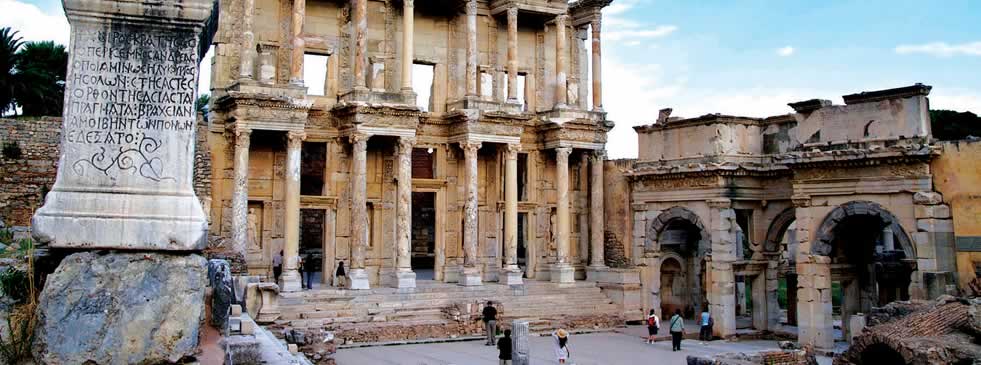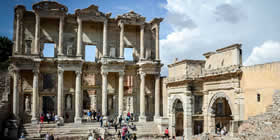Ancient Ephesus City is in Turkey
Quick Summary: Explore Ephesus, one of Turkey's most captivating historical sites, a place that has enchanted travelers and historians for centuries. As you step into the city founded in the 10th century BC by Attic-Ionian settlers, you'll be walking through the remnants of a metropolis that once housed 250,000 people. Ephesus is not just an ancient ruin; it's a treasure trove of history, culture, and architecture that draws over 1.5 million visitors every year, eager to immerse themselves in its past splendors. Today, the ruins of Ephesus stand as a monument to its significance in both Greek and Roman times, as well as its pivotal role in early Christianity. With so much to offer, Ephesus remains a must-visit for anyone interested in the ancient world.
It's Significance
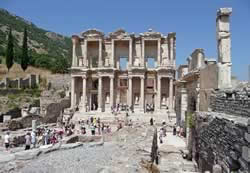
Ephesus is home to some of the most impressive landmarks in the ancient world, making it one of the best-preserved archaeological sites globally. Here are some of the main highlights that will take you on a journey back in time. The ancient city of Ephesus, pronounced Eph-e-sus (as [efəsəs]), is a true marvel, for it is a place of great historical, cultural and architectural significance.
- Library of Celsus: Built in 114 AD, this library once held over 12,000 scrolls and was the third-largest library in the ancient world. The ornate façade, with its Corinthian columns and intricate carvings, remains a stunning symbol of Ephesus's status as a center of learning. Visitors can walk through its towering arches and envision the scholars who once frequented its halls.
- Grand Amphitheater: This massive structure, capable of seating 25,000 people, was the hub of entertainment in Ephesus. It hosted everything from gladiatorial contests to large public assemblies and political debates. Today, it still resonates with history, having hosted modern performances by artists such as Elton John and Ray Charles. The theater's acoustics are so remarkable that standing at the bottom, you can hear a whisper from the top seats.
- Temple of Hadrian: Built in honor of Emperor Hadrian, this well-preserved temple offers a glimpse into the grandeur of Roman religious architecture. The detailed carvings on its frieze depict the legendary story of Androklos, the city's founder, and his faithful dog. This temple is an excellent example of the fusion of Greek and Roman artistic influences that define Ephesus.
- Terrace Houses: These luxurious homes, located on the slopes of Bülbül Mountain, belonged to the city's elite. Decorated with intricate mosaics and frescoes, these homes also had early versions of underfloor heating systems, showcasing the comfort and affluence that some citizens of Ephesus enjoyed. Walking through the well-preserved rooms, you can still see detailed artwork depicting scenes from daily life.
- Public Latrines: Although it may seem odd, these public latrines offer an interesting glimpse into the everyday lives of ancient Ephesians. Located near the Agora, these communal toilets were a part of public life and a testament to Roman engineering. These facilities were used in a very social way, with seats arranged around a central space where people could converse as they went about their business.
- Church of the Virgin Mary: Just outside the city ruins, this religious site is believed to be where the Virgin Mary spent her final days. Revered by both Christians and Muslims, this peaceful shrine draws thousands of pilgrims every year who come to pay their respects.
Ephesus is a city that invites exploration. With so many fascinating landmarks to visit, a full day is often not enough to take in all the history this ancient city has to offer.
Best Time to Visit
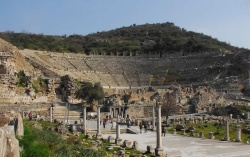
April, May, October, and November are the best months to visit Ephesus. During these months, the weather is mild, making it easier to explore the vast ruins without the oppressive heat or the cold winds that winter can bring. Spring, particularly April, offers blooming flowers around the site, adding extra beauty to your visit, while October and November have cooler temperatures and fewer crowds, ensuring a more peaceful experience.
If you choose to visit in the summer, be prepared for temperatures exceeding 35°C. In that case, it's best to arrive early in the morning to avoid both the heat and the large crowds of tourists that gather later in the day. Plan to spend at least six hours exploring the ruins thoroughly, and if you want to visit other nearby attractions, consider dedicating two full days to truly absorb everything Ephesus and its surroundings have to offer.
By placing the ideal travel times up front, you can immediately start planning your trip with confidence, knowing when you'll have the most enjoyable experience exploring this ancient city.
Location and Getting Here
Located just 1 km from the modern town of Selçuk, Ephesus is part of the Izmir district in Western Turkey. Its proximity to both the Aegean Sea and important trade routes made it one of the most important cities of the ancient world. Today, reaching Ephesus is straightforward, especially with Adnan Menderes Airport only 42 km away. From there, it's a quick 45-minute bus or minibus ride to the site.
Ephesus's prime location made it a crossroads of civilization. For modern travelers, the site is easily accessible:
Where to Find Ephesus
- 20 km from Kusadasi, a popular resort town and cruise ship stop
- 79 km from Izmir (Smyrna), a major port city and home to Izmir Airport
- 409 km from Antalya, A large city in Turkey and the capital of Antalya Province, famous for its agricultural produce
- 515 km from Istanbul, formerly known as Constantinople, Turkey's cultural and historical capital
- 1816 km from Jerusalem, making it part of a larger religious pilgrimage route.
More location and distances?
Ephesus Through Time: Rise, Fall, and Rediscovery
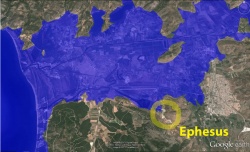
Founded by Greek colonists, Ephesus began as a trading post but soon became a bustling metropolis under Roman rule. The city flourished due to its strategic location along major trade routes, and at its peak, Ephesus covered over 1,000 acres, with a population that may have exceeded 250,000 people. By comparison, Rome during this time was larger, but Ephesus rivaled it in both architecture and culture.
However, Ephesus's fortunes began to decline in the 3rd century AD when Gothic invaders sacked the city and destroyed much of its infrastructure, including the Temple of Artemis. An earthquake in 614 AD further devastated the city, and its harbor slowly became unusable due to silt buildup. By the 15th century, Ephesus was abandoned.
The city's ruins lay buried for centuries until John Turtle Wood, a British architect and archaeologist, began his excavations in 1863. His discovery of the Temple of Artemis and other landmarks brought Ephesus back into the spotlight, and today, it's one of the most visited archaeological sites in the world. Yet, only 20% of the city has been uncovered, meaning there are still many secrets left to discover.

At its peak during Roman times, Ephesus was thought to be as big as 1,000 acres, with a population of maybe as high as 225,000 people. Therefore compared to Rome, it was not as large or as densely populated, though in culture and architecture it nevertheless looked just as amazing! This was a lot to do with religion, which has always been an important part of Ephesus' history and daily life throughout the centuries. And for a long time the city had been a center of pagan worship, especially of the Greek Goddess Artemis. Who was known by the Roman's as the Goddess Diana, whose name means 'Divine'.
The Roman Goddess Diana appears in the Bible several times and is associated with hunting, nature, as well as fertility. Though her temple in Ephesus was more commonly known by her Greek name of Artemis. Under that name, the grand Temple of Artemis at Ephesus was built from funds provided by the Ephesians themselves and the temple was completed sometime in the 4th Century B.C.
But only a few decades later, the Temple was burnt down by a man called Herostratus, who did it in the hope of becoming famous. Despite this set back, the temple was quickly rebuilt, but this time was made much bigger and far more grander than before. So much so it is said to be one of the original Seven Wonders of the ancient world.
Of the Seven Wonders of the Ancient World, only one still exists today and that is the Great Pyramid of Giza in Egypt. Of the other six, all were either lost or destroyed over time.
The Temple of Artemis was used for worship, as well as attracting visitors and the devout from all across the known ancient world. It also held regular ceremonies, public games and was the focal point for the many religious festivals held each year in the city.
Ephesus: A City of Trade and Religion
Ephesus was not just a cultural and political hub; it was also a critical center for trade and religion. The Temple of Artemis, one of the original Seven Wonders of the Ancient World, was the pride of Ephesus. Built in the 4th century BC, it attracted worshippers from all over the ancient world, making Ephesus a central point for pagan worship. Though only one column of the grand temple remains, it still stands as a reminder of the city's glory.
When the Romans took control of Ephesus, the city's role evolved, particularly in relation to early Christianity. The Apostle Paul spent three years in Ephesus, establishing one of the earliest Christian communities. His time here was pivotal in spreading Christianity across the Roman Empire. Later, Paul would write the Letter to the Ephesians, emphasizing the importance of unity among Christians.
The Apostle John, another significant figure in Christian history, also spent his final years in Ephesus. According to tradition, John wrote several key books of the New Testament while in the city, including the Book of Revelation. His tomb is located within the ruins of the Great Basilica of St. John, an important pilgrimage site for Christians around the world.
Ephesus Today
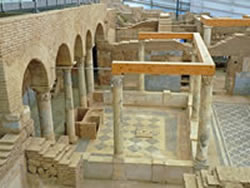
Modern-day Ephesus continues to captivate visitors from all over the world. With 1.5 million tourists annually, the site is a thriving tourist destination, offering both a deep dive into ancient history and a peaceful connection to the past. As archaeologists continue their work, more ruins and treasures are likely to be uncovered, ensuring that the city's legacy will endure for generations to come.
Whether you're an archaeology enthusiast, a history lover, or simply someone looking for an unforgettable experience, Ephesus is a destination that promises to transport you back to an age of grandeur, learning, and spirituality. So, pack your bags, lace up your walking shoes, and get ready to explore the ancient streets of Ephesus, where every stone tells a story.
So this ancient city is well worth a visit!
Shopping and Souvenirs
Once you've walked through the streets of ancient Ephesus, don't forget to stop by the local markets near the ruins to take home a piece of history. The area surrounding the site offers a variety of traditional Turkish crafts that make for perfect souvenirs:
- Nazar Boncugu (Evil Eye Charms): These blue charms are believed to ward off evil and bring good luck.
- Handwoven Turkish Carpets: Known for their intricate patterns and craftsmanship, Turkish carpets are a popular purchase.
- Ceramic and Copper Plates: Hand-painted and often featuring traditional designs, these make beautiful decorative pieces.
- Turkish Delight and Baklava: Sweet treats that are not only delicious but also iconic to Turkish cuisine.
- Gold and Diamond Jewelry: Crafted by local artisans, these pieces reflect the high-quality craftsmanship of the region.
Don't miss the chance to try local Turkish food. Dishes like manti (tiny meat-filled dumplings), lahmacun (a thin, crispy bread topped with minced meat), and şiş kebap (skewered grilled meat) are delicious options that give you a true taste of the region's culinary traditions.
The nearby shops also feature beautiful glass mosaic lamps and ceramic pottery, perfect for those who want to take home a more artistic souvenir. Be sure to also feed the friendly cats that roam the ruins, beloved by locals and tourists alike. The cats have become part of the charm of Ephesus, and it's customary to share some food and water with them as you explore the ancient streets.

